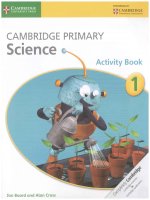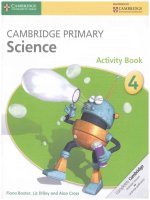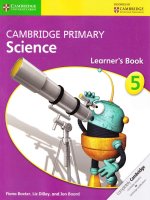cambridge primary science 3 2ed workbook
Bạn đang xem bản rút gọn của tài liệu. Xem và tải ngay bản đầy đủ của tài liệu tại đây (28.05 MB, 20 trang )
This workbook is filled with exercises that help your students practise what they
have learnt and encourage them to think and work scientifically. Focus, Practice and
Challenge exercises provide clear progression through each topic, helping learners
see what they’ve achieved. The drawing and writing activities give learners more
experience with scientific vocabulary, which helps them to develop their language
skills. These different types of exercises and activities make the book ideal for use
in the classroom or as homework.
Cambridge Primary
Cambridge Primary Science
For more information on how to access and use your digital resource,
please see inside front cover.
This resource is endorsed by
Cambridge Assessment International Education
✓ Provides learner support as part of a set of
resources for the Cambridge Primary Science
curriculum framework from 2020
✓ Has passed Cambridge International’s
rigorous quality-assurance process
✓
✓ For Cambridge schools worldwide
Developed by subject experts
Primary Science
Workbook 3
• Active learning opportunities help students apply their knowledge
to new contexts
• Three-tiered exercises in every topic help learners see and track their
own learning
• Varied exercise types keep learners interested
• Write-in for ease of use
• Answers to all activities can be found in the accompanying teacher’s resource
Science
9781108742771 Board and Cross Primary Science Workbook 3 CVR C M Y K
CAMBRIDGE
Workbook 3
Jon Board & Alan Cross
Completely Cambridge
Cambridge University Press works with Cambridge
Assessment International Education and experienced
authors to produce high-quality endorsed textbooks
and digital resources that support Cambridge teachers
and encourage Cambridge learners worldwide.
To find out more visit cambridge.org/
cambridge-international
Registered Cambridge International Schools benefit from high-quality programmes,
assessments and a wide range of support so that teachers can effectively deliver
Cambridge Primary.
Visit www.cambridgeinternational.org/primary to find out more.
Second edition
Digital access
CAMBRIDGE
Primary Science
Workbook 3
Jon Board & Alan Cross
University Printing House, Cambridge CB2 8BS, United Kingdom
One Liberty Plaza, 20th Floor, New York, NY 10006, USA
477 Williamstown Road, Port Melbourne, VIC 3207, Australia
314–321, 3rd Floor, Plot 3, Splendor Forum, Jasola District Centre, New Delhi –
110025, India
79 Anson Road, #06–04/06, Singapore 079906
Cambridge University Press is part of the University of Cambridge.
It furthers the University’s mission by disseminating knowledge in the pursuit of
education, learning and research at the highest international levels of excellence.
www.cambridge.org
Information on this title: www.cambridge.org/9781108742771
© Cambridge University Press 2021
This publication is in copyright. Subject to statutory exception and to the provisions
of relevant collective licensing agreements, no reproduction of any part may take
place without the written permission of Cambridge University Press.
First published 2014
Second edition 2021
20 19 18 17 16 15 14 13 12 11 10 9 8 7 6 5 4 3 2 1
Printed in ‘country’ by ‘printer’
A catalogue record for this publication is available from the British Library
ISBN 9781108742771 Paperback with Digital Access (1 Year)
Cambridge University Press has no responsibility for the persistence or accuracy of
URLs for external or third-party internet websites referred to in this publication, and
does not guarantee that any content on such websites is, or will remain, accurate
or appropriate. Information regarding prices, travel timetables, and other factual
information given in this work is correct at the time of first printing but Cambridge
University Press does not guarantee the accuracy of such information thereafter.
Cambridge International copyright material in this publication is reproduced
under licence and remains the intellectual property of Cambridge Assessment
International Education.
The exercises in this Workbook have been written to cover the Biology, Chemistry,
Physics, Earth and Space and any appropriate Thinking and Working Scientifically
learning objectives from the Cambridge Primary Science curriculum framework
(0846). Some Thinking and Working Scientifically learning objectives and the
Science in Context learning objectives have not been covered in this Workbook.
NOTICE TO TEACHERS IN THE UK
It is illegal to reproduce any part of this work in material form (including
photocopying and electronic storage) except under the following circumstances:
(i)ỵ� where you are abiding by a licence granted to your school or institution by the
Copyright Licensing Agency;
(ii)ỵ� where no such licence exists, or where you wish to exceed the terms of a licence,
and you have gained the written permission of Cambridge University Press;
(iii)ỵ�where you are allowed to reproduce without permission under the provisions
of Chapter 3 of the Copyright, Designs and Patents Act 1988, which covers, for
example, the reproduction of short passages within certain types of educational
anthology and reproduction for the purposes of setting examination questions.
Contents
Contents
How to use this book
1 ỵ� Plants are living things
1.1
1.2
1.3
1.4
ỵ� Alive or not aliveỵ�
ỵ� Plant parts ỵ�
ỵ� Plants need lightỵ�
ỵ� Plants need water and the right temperatureỵ�
2
7
10
13
2 ỵ� Mixing materials
2.1
2.2
2.3
2.4
2.5
ỵ� Solids, liquids and gasesỵ�
ỵ� Separating mixturesỵ�
ỵ� Dissolvingỵ�
ỵ� Filteringỵ�
ỵ� Separating materials from rocksỵ�
17
20
23
27
30
3 ỵ� Light and shadowsỵ�
3.1
3.2
3.3
3.4
ỵ� Shadowsỵ�
ỵ� Changing shadowsỵ�
ỵ� Transparent materialsỵ�
ỵ� Translucent materialsỵ�
34
37
40
43
iii
Contents
4 ỵ� Staying aliveỵ�
4.1
4.2
4.3
4.4
ỵ� Human organsỵ�
ỵ� Animal groups and different life cyclesỵ�
ỵ� Food chainsỵ�
ỵ� Fossilsỵ�
46
49
53
58
5 ỵ� Forces and magnets
5.1
5.2
5.3
5.4
5.5
ỵ� Forces and forcemetersỵ�
ỵ� Gravityỵ�
ỵ� Frictionỵ�
ỵ� Amazing magnetsỵ�
ỵ� Magnetic materialsỵ�
62
65
68
72
75
6 ỵ� The Earth and the Moon
6.1 ỵ� The shape of the Earth, Sun and Moonỵ�
6.2 ỵ� The Moonỵ�
6.3 ỵ� The phases of the Moonỵ�
iv
78
81
84
How to use this book
How to use this book
This workbook provides
questions for you to practise
what you have learned in
class. There is a topic to
match each topic in your
Learner’s Book. Each topic
contains the following
sections:
Focus: these questions help
you to master the basics
1.3 Plant and light
Practice: these questions
help you to become more
confident in using what you
have learned
Practice
Write the missing words.
leaves
small
tall
green
light
dark
[Black drawing of 2 plants in pots. One plant is tall with long stems and only
a few very small leaves. The other is shorter and has shorter stems, more
leaves and much larger leaves. The plants and leaves are a different shape
from those in the line drawing picture above.]
1 Living Things
Challenge: these questions
will make you think more
deeply
Challenge
Use the words to finish the sentences.
alive
not alive
Example: A ball is not alive.
A fish is ___________________.
A rock is __________________.
A cat can _____________.
A cat is ______________.
alive
not alive
food
move
The sun does not need ______________.
The sun is ________________.
1 Use the words to finish the sentences.
2 Write your own sentence about this living thing..
9
tree
leaves
big
small
tall
are
[b/w drawing
- Tall tree,
labeled ‘tree’
next to a lamp
post with
grass and sky
background]
v
1ỵ�
Plants are living
things
1.1 Alive or not alive
Focus
1ỵ� Look at these pictures. Draw each one in the correct group in the table.
ỵ�
plant
river
ỵ�
ỵ�
2
match
match
ỵ� match riverriver
clouds
plant
ỵ�
clock
clouds
tree tree
ỵ�
river
clouds clouc
ỵ� plantplant plantclouds
sheep
ỵ� clock
cactus
cactus
sheep
1.1 Alive or not alive
Alive
Not alive
3
1 Plants are living things
Practice
These are the seven rules to tell if something is a living thing.
...
moves
...can
have
young
it is alive
if it...
...needs
water and
food
...can sense
the world
around
...
grows
...makes
waste
...needs
air
2ỵ� aỵ� Look at the things in the table. Use the rules to decide if they are alive
or not.
Moves Needs
water
and
food
A goat
A cat
The Moon
A tree
A dolphin
An ant
4
�
�
Grows
Makes
waste
Needs
air
�
�
�
Can
Has Alive
sense young
�
�
�
1.1 Alive or not alive
bỵ� Complete these sentences using your answers from the table.
Pick one thing that is alive and one thing that is not alive.
Aỵ� I know
is alive because
.
Bỵ� I know
is not alive because
.
Challenge
Look at the pictures below.
rain
plastic building block
wood
frog spawn
fan
crab
rock
tree
5
1 Plants are living things
3ỵ�aỵ�Sort the things shown in the picture into the three groups
bỵ� Draw each thing in the correct box.
Living things
Things that were
once alive
4ỵ� Draw an object of your own in each box.
6
Things that have
never been alive
1.2 Plant parts
1.2 Plant parts
Focus
roots
leaf
flower
stem
1 Colour this plant and label it.
Use these words.
7
1 Plants are living things
Practice
Every part of the plant is important.
2ỵ� Draw an arrow from the plant part to its important job.
Plant part
Important job
To make food for the
plant.
roots
To hold the plant down
and absorb water from
the soil.
flower
To make seeds.
stem
To hold the plant parts
up and transport water.
leaf
8
1.2 Plant parts
Challenge
Sofia wonders what would happen if a plant did not have all these
plant parts: roots, flower, stem, leaf.
3 Write in the bubbles what you think would happen to a plant
without these plant parts.
9
1 Plants are living things
1.3 Plants need light
Focus
Four similar plants are put in different places.
A
B
C
D
1 Look at the picture and answer the questions. Use the letters A, B, C or D.
will grow well because it has most light.
a Plant
,
and
b Plants
because they have less light.
would grow better if it was moved to
c Plant
.
10
will grow less well
1.3 Plants need light
Practice
Two similar plants are growing.
One is in the light, the other is in a dark box.
The plants have water.
2ỵ� Draw what happens to the plants as they begin to grow.
11
1 Plants are living things
Challenge
Look at the four seeds below and the places they will grow.
They all get enough water, but will they grow well?
3 Look at the pictures and complete the sentences in the questions.
2
1
seed
seed
3
4
seed
seed
seed
a Plant
and
.
strongly because
b Plant
because
will not grow
and
will grow well
.
c Plants need light so that the leaves can make
12
.
1.4 Plants need water and the right temperature
1.4 Plants need water and
the right temperature
Focus
Plants need the right amount of water.
They also need the right temperature.
Look at these pictures. Is each plant growing well?
Plant A
Plant B
Plant C
1 Read these sentences.
Complete them by adding the right letter A, B or C.
a Plant
cannot grow well because it is too cold.
b Plant
cannot grow well because it is too hot.
c Plant
temperature.
can grow well because it has the right
13
1 Plants are living things
Practice
Three seeds were grown in different places.
A
B
sandy soil
C
good soil
stones
2 Complete these sentences.
Use these letters and words.
C
A
stones
water
absorb
sandy
root
good
a Plant B grew the best because the
soil held enough
enough
water for the plant to grow. The root could
water from the soil.
b Plant
grew the least because the
.
had no water. The root could not absorb any
c Plant
grew a little because the
absorbed a little water. The
water.
14
soil holds only a little
1.4 Plants need water and the right temperature
Challengeỵ�
Arun had two plants that were the same.
He gave water to one plant.
He did not give water to the other plant.
Every day he measured the height of the plants.
Here are the results on day 1 and day 10.
Height
With water (cm)
No water (cm)
Day 1
4
4
Day 10
8
3
3ỵ�aỵ� Draw the bar charts for each day.
Day 1
Day 10
9
9
8
8
7
7
Plant height (cm)
10
Plant height (cm)
10
6
5
4
3
6
5
4
3
2
2
1
1
0
0
water
no water
water
no water
15









